Washington
| |
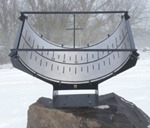 |
Goldendale |
Washington |
USA |
Cylindrical Dial |
Dial 242 |
| The sundial has a 53-inch semicircular steel equatorial ring and is 18-inches wide. The 18-inch rod gnomon is suspended above the dial by two horizontal rods. A small cross-bar in the middle of the gnomon acts as a nodus for telling the date. A mechanical adjustment allows for the equation of time correction. The dial is mounted on a large boulder on the Northwest end of the Goldendale Observatory close to the Solar Telescope Building. |
| |
| |
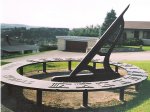 |
Grand Falls - Grand-Sault |
New Brunswick |
Canada |
Horizontal Dial |
Dial 559 |
| A horizontal dial using a 12 foot diameter blackened steel ring dial face and 8 foot high blackened steel gnomon. Dial face uses Roman numerals with XII at north. |
| |
| |
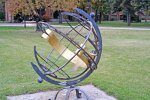 |
Grand Forks |
North Dakota |
USA |
Armillary Sphere |
Dial 282 |
| A large brass and cast iron armillary dial with full equatorial and equinoctial colure rings, two tropic rings and Arctic and Antarctic circle rings. The sphere is tilted so the gnomon rod points to celestial north pole. On the gnomon is a nodus for casting the noon day shadow on a plate with an engraved analemma. The whole armillary is mounted simply on a short four-legged stand. |
| |
| |
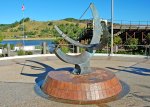 |
Grand Haven |
Michigan |
USA |
Equatorial Dial |
Dial 601 |
| A bronze equatorial dial approximately 6 feet high with bowstring gnomon. Hour markings show Daylight Saving Time and are longitude corrected. Dial sits atop a brick plinth. |
| |
| |
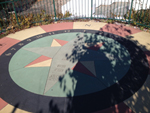 |
Grand Rapids |
Michigan |
USA |
Analemmatic Dial |
Dial 892 |
| The brightly colored analemmatic dial is approx 10.5 feet in diameter, surrounded by a ring of alternating red and white concrete with cardinal points. Time marks are set in a ring of black concrete, with large engraved hour numbers. Time is adjusted for daylight saving time.[Note that to tell time correctly, the time marks should be set on an ellipse.] The walkway for standing to cast your shadow has monthly names impressed into the concrete. |
| |
| |
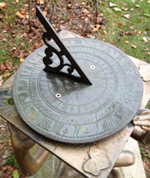 |
Grand Rapids |
Michigan |
USA |
Horizontal Dial |
Dial 287 |
| A cast iron statue of a small boy painted in gold and kneeling. With arms upright, he holds a plate on top of his head that held the original sundial face, surrounded by an inscription and ornamentation. The statue is bolted to a concrete pedestal. With the original sundial gnomon removed, a new oversized horizontal dial has been carelessly bolted onto the top plate. The gnomon and dial face imply it is a British reproduction, totally unsuited for the Michigan location. The dial face is ornate, with a compass rose in the center, surrounded by a chapter ring divided in 15 minute intervals. A second, outer chapter ring divides time into 5 minute intervals. Time is indicated with Roman numeral hour marks. Dial in good alignment, but illuminated by the sun only during early morning. |
| |
| |
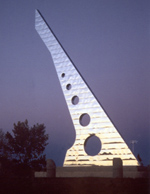 |
Grande Prairie |
Alberta |
Canada |
Horizontal Dial |
Dial 816 |
| This monumental stainless steel sundial was built as part of the Grande Prairie Millennium Project. The beautiful gnomon is 12m (40-feet) tall and symbolizes the passage of the year 2000 into the 21st century. Behind the visible stainless steel cover of the sundial's gnomon is a one by two foot steel beam. Engineers adopted computer programming techniques to construct and align the 30 centimetre thick gnomon of the Centre 2000 sundial. Specific factors such as the city’s elevation, its latitude and correction longitude mark time with the region’s Mountain Standard and Daylight Savings Time. |
| |
| |
 |
Granville |
Ohio |
USA |
Horizontal Dial |
Dial 528 |
| This horizontal sundial is built on a one-meter cube of red granite with a cast bronze gnomon supported by a cast bronze Pegasus modeled by New York artist Carl Paul Jennewein. The dial's plaza location overlooks the village of Granville and the valley beyond to the south. The dial is a tribute to Clifford S. Stilwell (Denison Class of 1912) who was Chairman of the Denison Board of Trustees at his death in 1941. The early B&W photograph of the Pegasus gnomon is courtesy of Denison University Archives. |
| |
| |
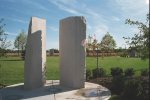 |
Graylake |
Illinois |
USA |
Sun Alignment |
Dial 521 |
| "Sun Pivot" is a set of vertical "gatestones" that allow the viewing of two major solar alignments: The summer sunrise stone is set about 33 degrees north of east while the equinox stone is set due east. The angular cuts in the gatestones allows the framing of the sunrise event above the stones, which are set about 200 feet away in a field of prairie grass. |
| |
| |
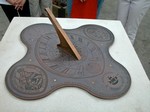 |
Great Falls |
Virginia |
USA |
Horizontal Dial |
Dial 633 |
| A phosphor bronze horizontal dial whose face is 17.7 inches across four rounded cruciform arms. Designed, made and presented by Tony Moss to commemorate the establishment of the first English settlement at Jamestown on May 14, 1607. The most striking feature is the inclusion of reproductions of the King James Great Seal of the English Virginia Company. The "navette" (little boat) shape of the seal is also reflected in a similar shape for the dial itself. These "English" features are balanced by an American input in the form of the "Celebrate Virginia" logo and that of the local Analemma Society that co-funded the pedestal along with Fairfax County Park Authority. A unique rounded-cruciform shape encompasses all the above elements together with the NASS logo and appropriate inscriptions. The dial is calibrated in 3-minute intervals and quarter hours. Square classical pedestal in reconstituted limestone made by Haddonstone UK. Pedestal is placed in a paved and railed area around the dial. A remarkable steel "safe" is provided to protect the dial and pedestal from theft or damage. |
| |
| |
 |
Great Falls |
Montana |
USA |
Equatorial Dial |
Dial 61 |
| A monumental bow-string equatorial dial of curved 4x6 inch welded steel I-beams forming a 14 foot diameter equatorial arc. Stainless steel Roman hour numerals 5 AM to 7 PM are welded to the arc. Metal for the dial was once used at Rainbow Dam and was formed and welded at Rainbow Powerhouse. |
| |
| |
 |
Great Falls |
Virginia |
USA |
Analemmatic Dial |
Dial 1012 |
| This 12-foot E-W analemmatic sundial was the Eagle Scout project of Kenny Dieffenderfer who marshaled volunteers from Troop 1547 and parents. The dial has hour marks of bright yellow radiant suns from 5am to 7pm local time. The zodiac walkway is 30 inches wide, painted with a white background and line marks for each month and appropriate colorful drawings. The equinox is clearly marked and surrounding the dial are the cardinal markers of N, S, E, W. |
| |
| |
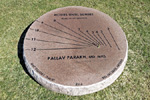 |
Greenfield |
Massachusetts |
USA |
Hours to Sunset |
Dial 475 |
| A 5 foot diameter pink Canadian granite horizontal hours-until-sunset dial. The 8 inch thick granite slab weighs 2000 pounds and rests on a short recessed pedestal, appearing to float above the grass dome of a memorial garden. Lines for hour periods 2-12 are marked with Arabic numerals. The gnomon is a 3/8 inch brass rod protruding 4 inches above the dial face.
The dial face is engraved, "HOURS UNTIL SUNSET" and, "READ TIP OF SHADOW."
This sundial does not function in the usual manner that tells time of day. Rather, this dial tells the number of hours from the present time of day to the time of sunset. These are equal-period hours counted down until sunset. Since it shows a time period, rather than time-of-day, the dial accuracy is not affected by season of year, daylight saving time or longitude location within the local time zone. Further, this particular design uses a horizontal dial face, while most hours-until-sunset dials use a vertical face.
This dial is dedicated as a memorial to Dr. Pallav Parakh, a much-loved surgeon who was killed in a tragic auto accident while walking in a crosswalk. |
| |
| |
|
Greensboro |
North Carolina |
USA |
Equatorial Dial |
Dial 277 |
| 33 ft. Bronze Sundial consisting of two intersecting semi-spherical arcs. Gift of the Greensboro Council of Garden Clubs, 1981. Mounted atop a 12 sided granite base. |
| |
| |
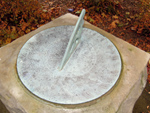 |
Greenville |
Pennsylvania |
USA |
Horizontal Dial |
Dial 912 |
| This bronze dial is about 14 inches in diameter with a coarse near-white patina. Time is delineated in 5 minute intervals from 4:30am to 5:30pm. The hours are marked in Roman numerals and includes a gnomon gap for a fairly thick gnomon. The dial sits on on square stone pillar and thick plinth. Measurement of the gnomon angle agrees with with latitude engraved on the dial plate of 40° 25' that is more than a degree off the latitude of the the dial site. |
| |
| |
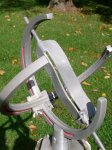 |
Greenville |
Delaware |
USA |
Equatorial Dial |
Dial 530 |
| A 15-inch cast aluminum equatorial sundial designed and built by Richard Schmoyer originally installed in 1972 and replaced in 1985 after theft. A three-dimensional analemmic gnomon corrects for Equation of Time. The observatory is open to the public every weekday morning. |
| |
| |
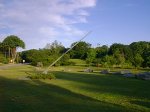 |
Greenwich |
Connecticut |
USA |
Horizontal Dial |
Dial 345 |
| Large horizontal dial is 130 ft. diameter and uses 15 hour stones to mark the time. Dial designed by Shope Reno Wharton Associates and built by sculptor Mark Mennin of Bethlehem, CT. The striking gnomon is a bronze tapered spike 8 in. at the base and 35 ft. 2 in. in overall length set in a 4 ft. bronze web, producing a 20 ft. high tip above the average grade. The noon stone is a flat marble slab 5 ft x 8 ft with a center score line. The 14 other hour stones are sculpted marble, each about 3 ft x 5 ft, abstractly depicting the progress of mankind's social progress across time. Only the first and last stone are marked with a time arrow. On the ground are two marble cubes with didactic bronze plates. Dial is adjacent to a pair of bronzed driftwood horse sculptures (full size). Dial site will be the first stop on the Bruce Museum school tour route. Gift from the Millennium Committee to the city of Greenwich |
| |
| |
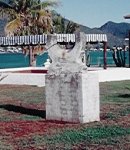 |
Guaymas |
Sonora |
Mexico |
Equatorial Dial |
Dial 388 |
| Dial is of stone, carved in a thick semi-circle ring about 200 degrees in extent. Dial is 36 inches in diameter and 10 inches thick. The inner rim of the dial is a "vee" shape. The gnomon is an iron rod protruding from the equatorial ring at the 12-hour mark, and at the center of the ring turns at a right angle to align to the north pole. The massive stone dial is set on a masonry block pedestal 40x40x20 inches. The pedestal is neither level nor cardinal. |
| |
| |
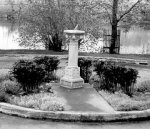 |
Guelph |
Ontario |
Canada |
Horizontal Dial |
Dial 370 |
| On the Sunnyside Estate front entrance is a small horizontal dial on a white pedestal surrounded by a flower garden. The original of this sundial is reputed to be the one that was mounted on the stump of the tree felled by John Galt in his ceremonial founding of Guelph on April 23rd, 1827. The original dial and pedestal were carved from Guelph limestone, and are in very poor condition. They were moved indoors during renovations in 1979. A replica now stands in the original position. See NASS Compendium Vol. 6 No. 3, Sept. 1999. |
| |
| |
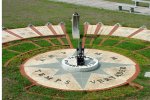 |
Habana |
La Habana |
Cuba |
Horizontal Dial |
Dial 564 |
| A monumental horizontal dial with rod gnomon and central cannon. First documented sundial in Cuba. |
| |
| |
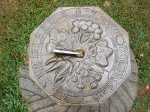 |
Hagerstown |
Maryland |
USA |
Horizontal Dial |
Dial 701 |
| A 16 inch octagonal bronze horizontal dial with hour lines and Arabic numerals. Dial face includes boldly raised representations of five different flowers identified by botanic names. Original gnomon has been replaced. Dial is placed atop an octagonal concrete pedestal with stone base. |
| |
| |
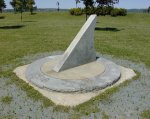 |
Halifax |
Nova Scotia |
Canada |
Horizontal Dial |
Dial 337 |
| The dial is a circle 8 feet in diameter on the ground, with Roman numerals. The gnomon is concrete, stone, standing about 4 foot high It is a memorial to the original black settlers who lived on Campbell Road in Africville and to the members of the Seaview United Baptist Church. The stone sundial, approximately four feet high and eight feet in diameter, rests on a concrete base and points North toward Bedford basin. Inscribed on the side of the monument are the family names of some of the early Africville residents. |
| |
| |
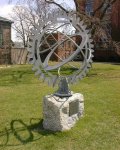 |
Halifax |
Nova Scotia |
Canada |
Armillary Sphere |
Dial 343 |
| This armillary sphere, made of steel and brass, is approximately 2 meters tall. The dial is the result of a collaboration between students from the 1997 Industrial Engineering class of the Technical University of Nova Scotia (now called DAL TECH) and a local shipbuilding firm who did the construction. The theme of industrial engineering is reflected in the cogwheel-like metal rings used in the construction. Initials of every classmate are punched into the cogs. On the plinth is the Equation of Time. |
| |
| |
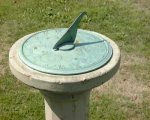 |
Halifax |
Nova Scotia |
Canada |
Horizontal Dial |
Dial 455 |
| This bronze horizontal dial is approximately 25 cm across on a one-meter high pedestal. Both the dial and dedication plate have a blue-green patina. The gnomon is slightly bent and appears to have been re-attached to the dial. The orientation remains true. Roman numerals mark the hours from 5 am to 7 pm. Hour lines plus half-hour marks. The concrete base is badly cracked and small pieces have fallen away. The dial is well-situated in an open area, but a nearby tree might shade the dial near midday during fall, winter, and spring. |
| |
| |
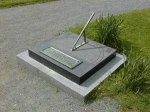 |
Halifax |
Nova Scotia |
Canada |
Horizontal Dial |
Dial 93 |
| Bronze horizontal dial on a granite base. Has Roman numerals showing time noting "Mean solar time in Halifax is 1 hour and 14 minutes behind Atlantic Standard Time." |
| |
| |
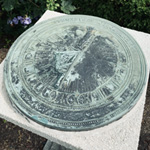 |
Halifax |
Nova Scotia |
Canada |
Horizontal Dial |
Dial 1100 |
| A bronze horizontal dial 36cm (14 in) in diameter with chapter ring of Roman numeral hours from V (am) to VII (pm). Hours are delineated in quarter hours and extend from 4am to 8pm (unmarked). Noon is designated by an "O". Gnomon has the inset profile of a bird. At south is father time with a scythe. The conglomerate pedestal is slowly disintegrating. |
| |
| |
 |
Halton Hills |
Ontario |
Canada |
Analemmatic Dial |
Dial 539 |
| A stone analemmatic dial with engraved seasonal dates and brass hour markers. The dial is located in Lucy Maude Montgomery Garden, built to celebrate the author of the Anne of Green Gable stories and who lived in Norval, now known as Halton Hills. |
| |
| |
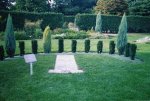 |
Hamilton |
Ontario |
Canada |
Analemmatic Dial |
Dial 341 |
| Construction of the dial and garden was supported by the Richard and Jean Ivey Fund of London, Ontario. An analemmatic dial about 25 feet wide with stone markers and metal numbers. |
| |
| |
 |
Hamilton |
New York |
USA |
Horizontal Dial |
Dial 403 |
| A small brass horizontal dial 9 1/2 inches in diameter. Has a compass rose in the center. Hour lines branching to half hour and quarter hour. Roman numerals showing 5am to 7pm. To the south of the gnomon is a graph of the equation of time. Donated to Colgate University by Fred Sawyer. The dial sits upon a rectangular granite column. |
| |
| |
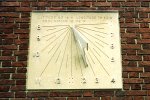 |
Hamilton |
Ontario |
Canada |
Vertical Dial |
Dial 492 |
| On the outside south wall of the library, about 15 feet above the ground is a vertical dial about one meter square. Dial is declined 18 deg 6 min west. The 1pm and 8pm numbers are missing. The dial is stone with aluminum gnomon and numbers. |
| |
| |
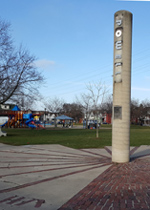 |
Hamilton |
Ontario |
Canada |
Obelisk or Vertical Gnomon |
Dial 856 |
| At first glance this appears to be a gnomonic dial with a concrete vertical gnomon about 15 feet tall casting its shadow onto a horizontal dial face about 60 feet in diameter in a slightly irregular pattern at one corner of a grass park. But something is seriously wrong for this to be a working sundial. Gnomonic dials tell time by the tip of their gnomon. The size of the gnomon implies that only several hours around noon in the summer could possibly tell time. We would expect that the gnomon is displaced from the center of the hour lines proportional to the height times tangent of the latitude. But here, the brick hour lines radiate centrally from the gnomon. More interesting, the hour lines (and their Roman numeral hour designation) are separated by a nearly uniform increment of 18 degrees per hour. That is, only five hours marks span from North to East. |
| |
| |
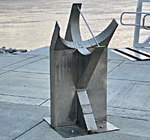 |
Hannibal |
Missouri |
USA |
Equatorial Dial |
Dial 1048 |
| A modernistic steel equatorial on a rectangular steel pillar. The gnomon rod shadow falls on an equatorial ring about 4-inches wide, showing time from V to VII, marked in hours and half hours. According to the Hannibal Courier-Post, "The sundial Scott Haycraft built 14 years ago is now back in its location at Glascock's Landing on the Hannibal riverfront...Haycraft built the 200-pound sundial with stainless steel. 'I wanted to make something that was functional art...' " |
| |
| |
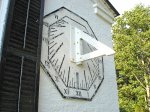 |
Hanover |
Vermont |
USA |
Vertical Dial |
Dial 702 |
| A four foot octagonal dial painted on the south wall of Shattuck Observatory. Dial face has hour lines with 15 minute marks and Roman numerals. Dial need repainting. |
| |
| |
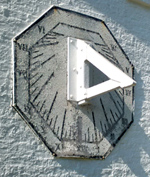 |
Hanover |
New Hampshire |
USA |
Vertical Dial |
Dial 832 |
| This octagonal vertical sundial is mounted on the due south facing wall of Shattuck Observatory. The dial is painted on wood. The hours are VI to VI (6 am to 6 pm) with lines for half and quarter hours. The thick triangular gnomon is rigidly mounted on the dial face. The dial is in excellent mechanical condition but the paint is flaking badly due to sun and weather exposure. |
| |
| |
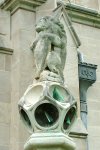 |
Hartford |
Connecticut |
USA |
Polyhedral Dial |
Dial 27 |
| This is an 18th century polyhedral dial (dodecahedron). The dial was originally located at The Abbey, Storrington, Sussex, England. Carved stone with ten dials on a dodecahedral, some sunken, some planar. Pillar is about 12 ft. high. |
| |
| |
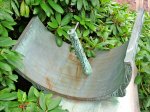 |
Hartford |
Connecticut |
USA |
Equatorial Dial |
Dial 28 |
| A bronze equatorial dial presented to the college as a gift from the class of 1889. For its age, it is in remarkably good condition. The 3 foot wide by 2 foot tall half cylinder is engraved with both hour and declination lines. At the noon-equinox point of the dial face a perpendicular pole rises to the centerline of the cylinder and supports a N-S gnomon rod. Unfortunately the southern portion of the rod is missing. The base is a square, tapered pillar. |
| |
| |
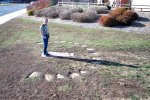 |
Hastings |
Minnesota |
USA |
Analemmatic Dial |
Dial 640 |
| A 5x3 meter analemmatic dial of natural limestone rocks with red flagstone and white limestone for month markers. Arabic hour numerals and month names are sandblasted into the stones. This dial was designed and built as an Eagle Scout project with an original request from the school science teacher, Mr. Rapatz. Roger Bailey of NASS provided technical guidance. |
| |
| |
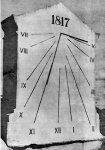 |
Havana |
Havana |
Cuba |
Vertical Dial |
Dial 717 |
| A carved stone, south-facing vertical dial with polar-pointing gnomon, hour lines and Roman hour numerals. The construction date of 1817 is prominently shown at the top of the dial. This is a historic Cuban sundial, known at the "dean of Cuban sundials" and referenced in "This is Cuba, Things of My Country." |
| |
| |
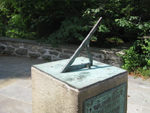 |
Haverford |
Pennsylvania |
USA |
Horizontal Dial |
Dial 1019 |
| A rectangular horizontal dial about 18 x 12 inches. Heavily weathered, but Roman hour lines from 6am to 6pm with noon gap still visible. Original 5 minute hour marks barely visible on rim. The gnomon went missing some years ago and was retrieved on eBay, and is retained by the college. |
| |
| |
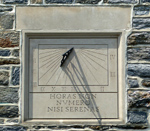 |
Haverford |
Pennsylvania |
USA |
Vertical Dial |
Dial 1020 |
| Vertical dial about 2-foot square high up on the east wing of KINSC. The limestone dial is embedded in the stone block wall. The declining dial has hour lines every half hour from 5am to 4:30pm. The gnomon is in excellent condition and has not left brass stains on the dial face. |
| |
| |
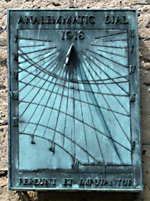 |
Haverford |
Pennsylvania |
USA |
Vertical Dial |
Dial 1021 |
| This bronze vertical dial is about 2x3 feet with a splotched green patina. The hour lines and Roman markers go from 5am to 7pm. The tip of the gnomon shadow shows the date among declination lines from solstice to solstice. It is inscribed as an analemmatic dial, but only because at the noon hour is the trace of the analemma. Considering the motto on the dial, this was probably erected as a memorial to those lost in The Great War. |
| |
| |
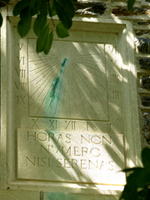 |
Haverford |
Pennsylvania |
USA |
Vertical Dial |
Dial 1022 |
| Not too far up the wall of Union Hall is this vertical rectangular dial about 2x3 foot in size. The limestone dial is embedded in the stone block wall. The declining dial has hour lines every half hour from 5am to 6pm, but the gnomon is missing, leaving only a bronze stain on the light stone face. Most disturbing is a magnolia tree planted by the class of 1972 that now totally blocks sunlight from reaching the dial. |
| |
| |
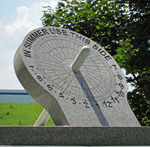 |
Hawthorn Woods |
Illinois |
USA |
Equatorial Dial |
Dial 876 |
| This equatorial dial sits on a 61-inch octagonal base that serves as a columbarium. The dial is reminiscent of Erickson Memorial sundials. This granite sundial is 38.5 inches in diameter and 6 inches thick. The 3-inch diameter gnomon is made of hollow galvanized steel pipe with a white powder coating. The engraving on the sundial was done using a rubber stencil and sandblasting with aluminum oxide abrasive. No water jet was used. The center core hole was cut using a diamond segmented coring machine, like a big drill press with an expensive hole saw. |
| |
| |
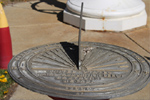 |
Hawthorne |
Nevada |
USA |
Horizontal Dial |
Dial 1080 |
| Farenholt sundial for U.S. Naval Ammunition Depot Hawthorne Nevada. This cast bronze dial was designed and commissioned by RADM Farenholt for U.S. Naval Hospitals at bases where he was commanding officer, visited, or had special meaning to him. The dial is 18 inches (46cm) in diameter. The outer chapter ring has the motto, followed by a chapter ring with Arabic hours 6am to 6pm, raised hour lines that radiate from near the foot of the gnomon and short half-hour lines. The gnomon has graceful curves and a star cut-out in the center. Below the gnomon is the naval command name, followed by the commissioning date in the southern portion of the hours chapter ring. |
| |
| |
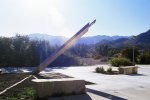 |
Heber City |
Utah |
USA |
Horizontal Dial |
Dial 531 |
| A 51 x 36 foot horizontal dial with a 21 foot welded silicon bronze gnomon standing 14 feet high. The hour lines are copper inlaid in concrete and the hour markers are 4 inch high bronze Arabic numerals. At solar noon, sunlight passing through a slit in the gnomon illuminates the noon marker with a line of sunlight while prisms on the end of the gnomon project rainbows onto this line of light, making the sculpture a seasonal calendar as well as a way to tell time.
Created by sculptor Robert Perless, Sun Dagger functions as a unique celestial observatory to amplify the synergy of man and nature. It also works as a seasonal calendar, celebrating the winter and summer solstices and the vernal and autumnal equinoxes with rainbows crossing the line of sunlight from the gnomon slit and falling on inscribed plaques. |
| |
| |
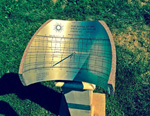 |
Heber City |
Utah |
USA |
Cylindrical Dial |
Dial 47 |
| A 10 inch wide, cylindrical-segment equatorial dial 8 inches high, fabricated from a section of large PVC pipe. The dial face is aluminum sheet bonded to the PVC pipe and marked by photochemical engraving with hour lines showing analemmas to correct for EOT; hour lines are corrected for longitude and show both standard and daylight saving Arabic hour numerals. Winter and summer solstices and equinoxes are marked. The gnomon is a pointed brass rod. Instructions for use are included on dial face. |
| |
| |
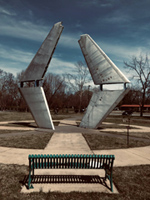 |
Hermitage |
Tennessee |
USA |
Horizontal Dial |
Dial 1055 |
| The gnomon consists of two complete horizontal stabilizer wings from a Boeing 727 jet, arranged in a sculpture called "Clear for Landing". The dial is 72 feet (22m) in diameter. The hour markers are Roman numerals in granite stone blocks. The hour lines were laid out using a scale model mounted on a heliodon and set for the summer solstice. The leading shadow of the vertical sculture marks the time. The planes landing at Nashville airport serve as the backdrop to the dial. When the sun is due East-West, the wings form a diamond, allowing shadows to fall through the markers onto the inlaid concrete disk. |
| |
| |
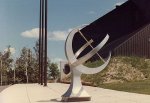 |
Hibbing |
Minnesota |
USA |
Equatorial Dial |
Dial 375 |
| An 8 ft high equatorial sundial designed and built by David Aho. Made of welded stainless steel with a brass gnomon and brass equatorial arc dial. The 60 inch diameter equatorial dial is engraved. |
| |
| |
 |
Highland Park |
Illinois |
USA |
Polar Dial |
Dial 377 |
| This cast iron polar dial is centered in a 7 foot diameter, echoing the form of a "train wheel", matching the theme of a small park situated between a historic train station on the ancient Green Bay Trail and a pioneer cemetery. The polar dial has raised hour lines on the cast iron plate. Designed by Stephen Luecking and built at St. Mary's Foundry. |
| |
| |
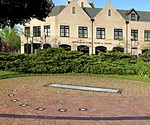 |
Highland Park |
Illinois |
USA |
Analemmatic Dial |
Dial 400 |
| A nicely done analemmatic dial approximately 15 feet across with a grey granite zodiac walkway. The granite walkway has a central line, crossed with month marks for standing at the date of the year. An unusual feature of the dial is that the Equation of Time (EoT) correcting solar time to civil time is given at the left and right edges of the dial. On the first, tenth, and twentieth of each month the EoT is inscribed to the nearest minute. The walkway is surrounded by one row of dark brick then encompassed by a large plaza of light red brick. Embedded in the plaza are small square Roman numeral hour marks, arranged for summer viewing with 1pm set to north. The plaza is in a nicely landscape area of grass, bushes, perennials, three large pots of flowers and a bench.. |
| |